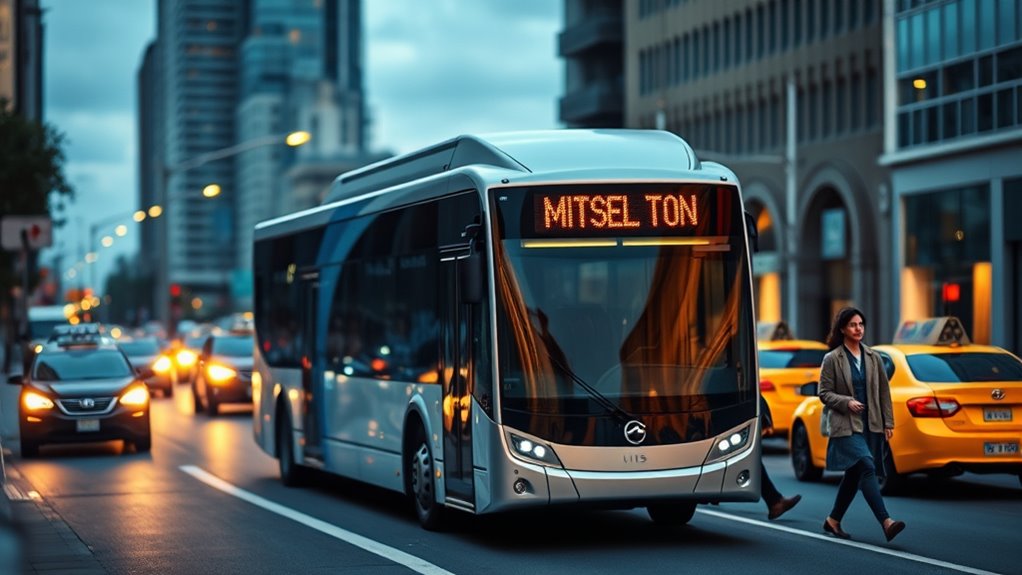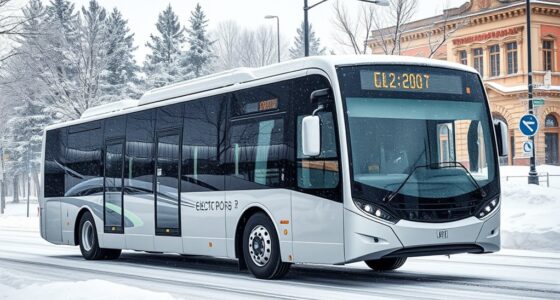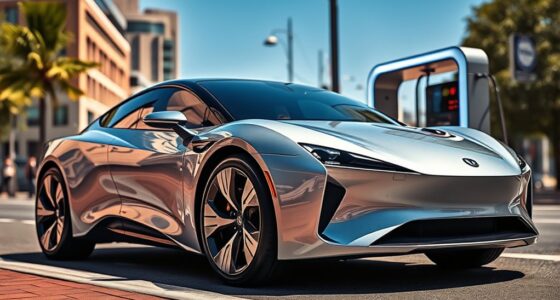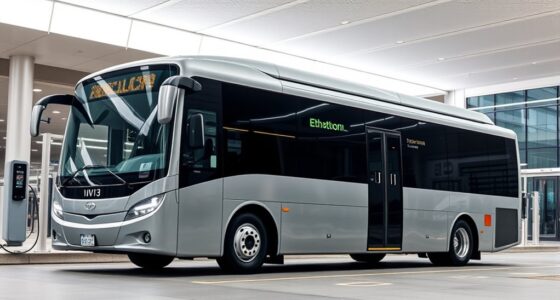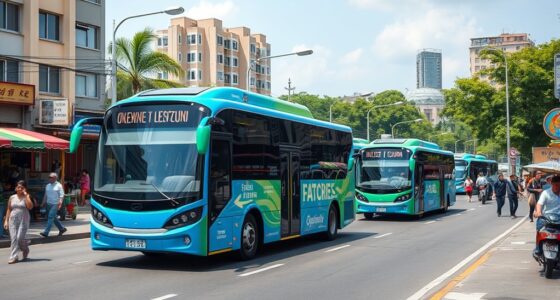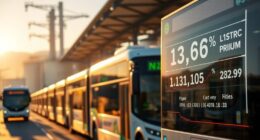Electric buses crucially cut noise pollution in cities by operating silently and reducing engine noise and vibrations. This creates a quieter urban environment, lowering noise levels and improving your daily life. Fewer disturbances help reduce stress, enhance community health, and foster calmer neighborhoods. Plus, their eco-friendly design benefits everyone’s well-being. If you want to learn how electric buses contribute to a more peaceful, sustainable city, keep exploring their essential role in reducing urban noise.
Key Takeaways
- Electric buses produce minimal engine noise, significantly lowering urban noise levels and creating quieter city streets.
- They help reduce noise-induced health issues like stress, sleep disturbances, and cardiovascular problems among residents.
- Electric buses support environmental sustainability by decreasing greenhouse gas emissions and promoting eco-friendly urban transit.
- Quieter operation enhances safety, communication, and overall community well-being in urban environments.
- Adoption of electric buses is often encouraged through policies and incentives, amplifying their role in noise pollution reduction.
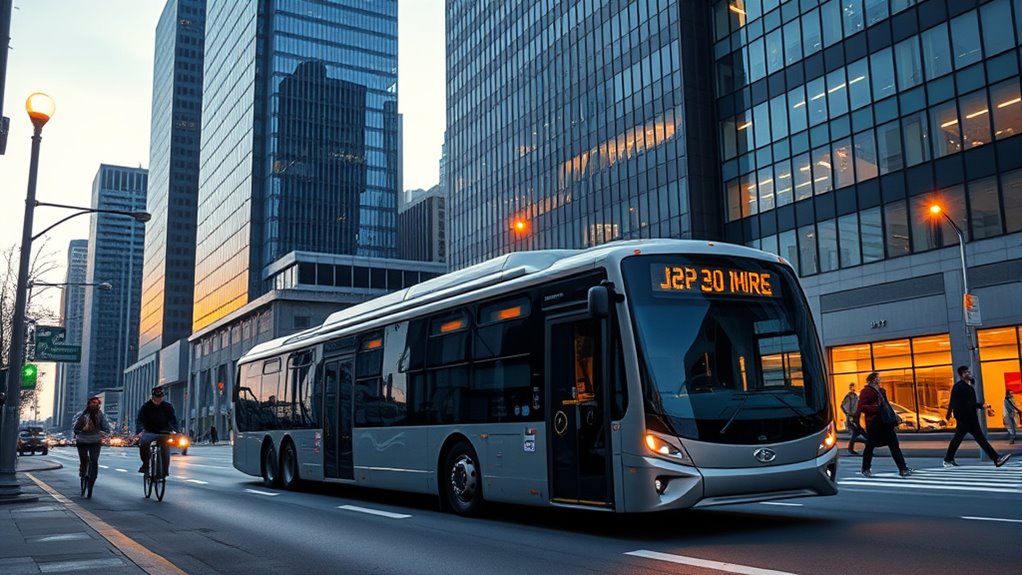
Electric buses are transforming urban transportation by markedly reducing noise pollution, which is a major concern in densely populated cities. Traditional diesel buses are one of the largest contributors to urban noise, emitting loud engine sounds and vibrations that disrupt daily life. When you switch to electric buses, you experience a quieter environment because these vehicles produce almost no engine noise and minimal vibration. This reduction considerably enhances urban tranquility and makes city streets more peaceful.
Electric buses significantly reduce urban noise, creating quieter, more peaceful city streets and a healthier environment for all.
As a resident or commuter, you’ll notice less background noise during your daily routines, leading to a more pleasant living experience.
Reducing noise pollution isn’t just about comfort; it also has tangible health benefits. Prolonged exposure to high noise levels can cause stress, sleep disturbances, cardiovascular problems, and even cognitive impairments. By replacing diesel buses with electric alternatives, you help decrease these health risks for yourself and your community.
Studies show that electric buses can cut urban noise levels by up to 4.4 decibels, making a noticeable difference in your neighborhood’s soundscape. Less noise means fewer disturbances at homes, schools, and workplaces, enabling everyone to enjoy a calmer, more focused environment. Noise reduction techniques are essential in designing healthier urban spaces. Incorporating urban planning that considers noise abatement can further amplify these benefits.
Beyond health, electric buses contribute to a more sustainable and cleaner city. They help improve air quality by reducing greenhouse gas emissions, which is essential for combating climate change. Lower emissions combined with quieter operation support efforts to create healthier, more sustainable urban spaces.
When you see electric buses on your streets, you’re witnessing a step toward greener transportation that benefits both the environment and your quality of life. This shift aligns with global goals to promote sustainable transit systems, ensuring that cities become more livable for current and future generations.
As a city resident, you also gain personal advantages from electric buses. The quieter operation enhances communication with drivers and fellow passengers, making interactions clearer and less stressful. For children and elderly neighbors, reduced noise levels mean less annoyance and a more peaceful community.
Electric buses help foster a sense of calm and safety, making urban spaces more inviting. When streets are quieter, you experience a greater sense of well-being and community cohesion, contributing to a higher overall quality of life.
Technical and operational benefits support this change. Electric buses operate more efficiently, requiring less maintenance and leading to cost savings over time. Their quiet nature not only benefits passengers but also improves driver safety, as clearer communication becomes easier.
Governments often support this shift through incentives and policies aimed at encouraging sustainable transportation. Overall, electric buses play a key role in reducing noise pollution, making cities healthier, quieter, and more sustainable for everyone. Additionally, incorporating biodiversity-friendly urban planning can further enhance the benefits of quieter, greener cities.
Frequently Asked Questions
How Do Electric Buses Impact Urban Air Quality Beyond Noise Reduction?
You might wonder how electric buses affect urban air quality beyond just noise reduction. When you switch to electric, you’re cutting emissions of harmful pollutants like nitrogen oxides and particulate matter.
This leads to cleaner air, healthier residents, and a reduction in respiratory issues. Plus, electric buses help lower greenhouse gases, contributing to climate change mitigation.
What Are the Cost Implications of Transitioning to Electric Buses Citywide?
Moving to electric buses citywide involves significant upfront costs, as each bus can exceed $1 million. However, you’ll save money long-term through lower fuel and maintenance expenses, potentially saving up to $173,000 per bus over its lifetime.
Incentives, government grants, and discounted financing can help offset initial expenses. Plus, you’ll benefit from reduced emissions and healthier urban environments, making the investment worthwhile for your city’s future.
How Do Electric Buses Compare to Traditional Buses in Maintenance Requirements?
You’ll find electric buses have simpler maintenance needs than traditional diesel buses. They lack many moving parts, so you won’t need oil changes or exhaust repairs.
Regenerative braking reduces brake wear, and fewer fluids mean less routine upkeep.
While battery monitoring and charging station maintenance are necessary, overall, electric buses cost less to maintain over their lifespan.
Just remember, battery health checks and software updates are key to keeping them in top shape.
Are There Any Challenges in Implementing Electric Bus Infrastructure?
You’ll face several challenges when implementing electric bus infrastructure. High upfront costs for charging stations and real estate can be barriers.
Grid capacity limitations and energy demand spikes may require costly upgrades. Route-contract mismatches and depot space constraints complicate deployment.
Additionally, fragmented policies and public-private coordination gaps make planning tougher. Without proper data and planning, operational inefficiencies and maintenance issues can also arise, slowing down adoption and effective integration.
How Do Electric Buses Influence Overall Urban Transportation Planning?
You see, electric buses influence urban transportation planning by shaping how cities develop their transit systems. They encourage integrating sustainable modes like cycling and walking, prompting planners to optimize routes and depots.
You also need to take into account charging infrastructure placement, urban landscape impacts, and aligning with broader transit goals. By doing so, you create a more efficient, eco-friendly, and attractive transportation network that benefits residents and the environment alike.
Conclusion
As you imagine city streets suddenly hushed, electric buses take center stage, their silent engines weaving a calm through bustling chaos. You feel the gentle reduction in noise, like a soothing whisper replacing a thunderous roar. This quiet transformation paints a picture of healthier, more peaceful urban life, where the hum of progress is soft and serene. Embracing electric buses isn’t just about innovation; it’s about reclaiming the tranquil soundtrack of your city’s future.
